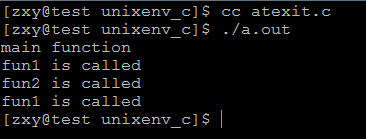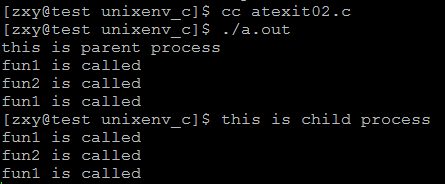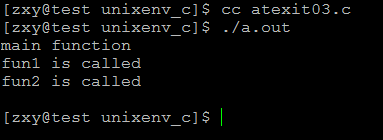一,进程终止有5种方式:
正常退出:
- 从main函数返回
- 调用exit
- 调用_exit
异常退出:
- 调用abort
- 由信号终止
二,exit和_exit区别:
关于_exit():
#include <unistd.h>
void _exit(int status);
#include <stdlib.h>
void _Exit(int status);
DESCRIPTION
The function _exit() terminates the calling process "immediately". Any
open file descriptors belonging to the process are closed; any children
of the process are inherited by process 1, init, and the process’s par-
ent is sent a SIGCHLD signal.
The value status is returned to the parent process as the process’s
exit status, and can be collected using one of the wait(2) family of
calls.
The function _Exit() is equivalent to _exit().
关于exit():
#include <stdlib.h>
void exit(int status);
DESCRIPTION
The exit() function causes normal process termination and the value of
status & 0377 is returned to the parent (see wait(2)).
All functions registered with atexit(3) and on_exit(3) are called, in
the reverse order of their registration. (It is possible for one of
these functions to use atexit(3) or on_exit(3) to register an addi-
tional function to be executed during exit processing; the new regis-
tration is added to the front of the list of functions that remain to
be called.) If one of these functions does not return (e.g., it calls
_exit(2), or kills itself with a signal), then none of the remaining
functions is called, and further exit processing (in particular, flush-
ing of stdio(3) streams) is abandoned. If a function has been regis-
tered multiple times using atexit(3) or on_exit(3), then it is called
as many times as it was registered.
All open stdio(3) streams are flushed and closed. Files created by
tmpfile(3) are removed.
The C standard specifies two constants, EXIT_SUCCESS and EXIT_FAILURE,
that may be passed to exit() to indicate successful or unsuccessful
termination, respectively.
和exit比较一下,exit()函数定义在stdlib.h中,而_exit()定义在unistd.h中,
注:exit()就是退出,传入的参数是程序退出时的状态码,0表示正常退出,其他表示非正常退出,一般都用-1或者1,标准C里有EXIT_SUCCESS和EXIT_FAILURE两个宏,用exit(EXIT_SUCCESS);
_exit()函数的作用最为简单:直接使进程停止运行,清除其使用的内存空间,并销毁其在内核中的各种数据结构;exit() 函数则在这些基础上作了一些包装,在执行退出之前加了若干道工序。
exit()函数与_exit()函数最大的区别就在于exit()函数在调用exit系统调用之前要检查文件的打开情况,把文件缓冲区中的内容写回文件,就是"清理I/O缓冲"。
exit()在结束调用它的进程之前,要进行如下步骤:
1.调用atexit()注册的函数(出口函数);按ATEXIT注册时相反的顺序调用所有由它注册的函数,这使得我们可以指定在程序终止时执行自己的清理动作.例如,保存程序状态信息于某个文件,解开对共享数据库上的锁等.
2.cleanup();关闭所有打开的流,这将导致写所有被缓冲的输出,删除用TMPFILE函数建立的所有临时文件.
3.最后调用_exit()函数终止进程。
_exit做3件事(man):
1,Any open file descriptors belonging to the process are closed
2,any children of the process are inherited by process 1, init
3,the process's parent is sent a SIGCHLD signal
exit执行完清理工作后就调用_exit来终止进程。
三,atexit()
atexit可以注册终止处理程序,ANSI C规定最多可以注册32个终止处理程序。
终止处理程序的调用与注册次序相反
#include <stdlib.h>
int atexit(void (*function)(void));
DESCRIPTION
The atexit() function registers the given function to be called at nor-
mal process termination, either via exit(3) or via return from the pro-
gram’s main(). Functions so registered are called in the reverse order
of their registration; no arguments are passed.
The same function may be registered multiple times: it is called once
for each registration.
POSIX.1-2001 requires that an implementation allow at least ATEXIT_MAX
(32) such functions to be registered. The actual limit supported by an
implementation can be obtained using sysconf(3).
When a child process is created via fork(2), it inherits copies of its
parent’s registrations. Upon a successful call to one of the exec(3)
functions, all registrations are removed.
RETURN VALUE
The atexit() function returns the value 0 if successful; otherwise it
returns a non-zero value.
示例程序:
#include <stdio.h> #include <unistd.h> #include <stdlib.h> void fun1() { printf("fun1 is called "); } void fun2() { printf("fun2 is called "); } int main(void) { printf("main function "); atexit(fun1); atexit(fun2); atexit(fun1); exit(EXIT_SUCCESS); }
运行结果:
当调用fork时,子进程继承父进程注册的atexit:
示例程序:
#include <stdio.h> #include <unistd.h> #include <stdlib.h> #define ERR_EXIT(m) do { perror(m); exit(EXIT_FAILURE); } while (0) void fun1() { printf("fun1 is called "); } void fun2() { printf("fun2 is called "); } int main(void) { pid_t pid; pid = fork(); atexit(fun1); atexit(fun2); atexit(fun1); if(pid == -1) ERR_EXIT("fork error"); if(pid == 0){ printf("this is child process "); } if(pid > 0){ printf("this is parent process "); } return 0; }
运行结果:
当atexit注册的函数中有一个没有正常返回或被kill,则后续的注册函数都不会被执行
示例程序:
#include <stdio.h> #include <unistd.h> #include <stdlib.h> #include <signal.h> void fun1() { printf("fun1 is called "); } void fun2() { printf("fun2 is called "); kill(getpid(),SIGINT); } int main(void) { printf("main function "); if(signal(SIGINT,SIG_DFL) == SIG_ERR){ perror("signal error"); exit(EXIT_FAILURE); } atexit(fun1); atexit(fun2); atexit(fun1); exit(EXIT_SUCCESS); }
运行结果:
可见最后那个fun1没有执行



